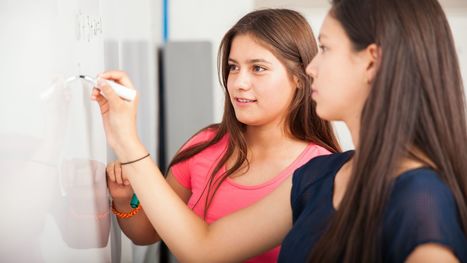 Your new post is loading...
 Your new post is loading...

|
Scooped by
John Evans
|
There are a variety of sources of student errors in math, and labeling them ‘careless’ might mean missing a chance to help students learn.

|
Scooped by
John Evans
|
A popular strategy, using pictures in math class gives students another way to access math concepts and can spark great conversations.

|
Scooped by
John Evans
|
Mathematics is created by humans, math teachers are humans and math students are humans. Yet many contemporary math classrooms erase humans from the equation.
“Often mathematics is talked about as if it were apolitical, objective, and cold. A sterile textbook, a teacher writing on a chalkboard and rarely turning around,” said Sam Shah, a high school math teacher in Brooklyn, New York.
For many students, that model of math class is unengaging or anxiety-provoking.

|
Scooped by
John Evans
|
As we head back into the school year many educators are working thoughtfully to create environments that are rich with math possibility. In Reggio Emilia the environment exists as the 'third teacher' inspiring, supporting, and extending children's learning in rich and complex ways. I have been contacted by many educators asking for advice on how to best set up their classroom and routines in order to create as many opportunities for authentic math as possible. This has inspired today's blog post - how to cultivate a math rich learning space for children at the beginning of another school year.
I thought it would be easiest to create this as a 'math check list' with points to read and consider. When I reflect upon my own math pedagogy and practice, these are what I think stand out as mathematically meaningful for the educators, children and families that share our space. Although this check list isn't all inclusive, I thought it might spark some ideas to support and inspire as we enjoy the final weekend of summer and start back in our classroom with open eyes, minds and hearts this week.

|
Scooped by
John Evans
|
We have been teaching students how to become better readers and writers for years. With mentor texts, we teach our students about the different genres, text structures, and features that exist within books. Students learn how to identify characters and plots, retell events, or set up a table of contents to reflect the main idea and details of a new writing piece.
The good news is, we can use these same instructional choices during our math instruction. Just as books have a variety of text structures (narrative, informational, biographical) and features (characters, events, language, labels) so too, do math word problems. When we show students how to identify these structures and features within math problems, we increase their ability to comprehend them, solve them, and eventually become the authors of their own math stories. Research shows that readers who can identify the structure of a text are better able to locate the information they need for successful comprehension (Williams, J.P., 2003). This is exactly the result we are looking for when students are solving word problems. We want students to identify the text structure of a math problem, recognize which part is missing, and use questions and known relationships to solve for the missing value.
Math educator Dan Finkel grew up doing math with ease and completed calculus as a freshman in high school. But it wasn't until he went to math summer camp and learned how to think like a mathematician that he truly fell in love with math. It helps to have a positive relationship with math because when people are uncomfortable with it they are susceptible to manipulation. (Think of predatory lending interest rates, convenient statistics to support a thin argument, graphs that misrepresent the truth.)
“When we’re not comfortable with math, we don't question the authority of numbers,” said Finkel in his TEDx Talk, “Five ways to share math with kids.”
There are many resources on the Centre for Education in Mathematics and Computing (CEMC). Not only are there years of past University o
Via Tom D'Amico (@TDOttawa)

|
Scooped by
John Evans
|
Many educators across the world will be inspired to engage their students in a coding lesson this week, as December 3-9 is Code.org’s annual Hour of Code event. Coding is not only great as an elective or extra activity, it can also provide an avenue to apply and deeply engage in mathematical concepts. Perhaps we should consider including coding as part of our mathematics explorations more often!
For instance, our board member, Mike Lefkowitz wrote about how mathematics provides the foundation for the other STEM subjects, including science, technology and engineering. Similarly, the president of the National Council of Teachers of Mathematics, Matt Larson, made a compelling argument that math education is STEM education. So maybe it makes sense to build these skills in conjunction with one another, and support students in identifying those connections.
Other articles have also explored upon how coding can help students make sense of the eight mathematical practices, and here I endeavor to showcase more examples and anecdotes from colleagues working in technology.

|
Scooped by
John Evans
|
"Are you a fan of Rubik’s Cube? Do you like to build something to solve a problem? Here is one of our favorite puzzles!"

|
Scooped by
John Evans
|
"When will I ever use this?" It's a question math and science teachers hear all the time from their high school students.
Teaching science, technology, engineering and math (STEM) skills is more important than ever, but it's often difficult for students to understand the practical applications of such fundamental learning and how it will help them down the road.
Classroom activities should be relevant, meaningful and connected to students' prior knowledge and experiences. Learning must be based on lived experiences within both formal and informal educational settings.
Increasingly, teacher educators are realizing that we must break away from traditional silos of courses, disciplines and formal schooling. Educators must lead by example and provide students with opportunities to explore interdisciplinary approaches to learning.

|
Scooped by
John Evans
|
This year I connected with the passionate team behind Woot Math. If you are looking for a tool to energize your math instruction this year, Woot Math has you covered! From engaging activities to embedded formative assessment, this platform is perfect for K-12 students. It’s free for teachers, so if you can’t wait to jump in, scroll to the bottom of this post to set up an account.

|
Scooped by
John Evans
|
For parents who want to encourage their daughters in STEM subjects, it’s crucial to remember this: Math is the sine qua non.
You and your daughter can have fun throwing eggs off a building and making papier-mâché volcanoes, but the only way to create a full set of options for her in STEM is to ensure she has a solid foundation in math. Math is the language of science, engineering and technology. And like any language, it is best acquired through lengthy, in-depth practice.
But for girls, this can be trickier than it looks. This is because many girls can have a special advantage over boys — an advantage that can steer them away from this all-important building block.

|
Scooped by
John Evans
|
The mind-body connection is widely accepted in health and wellness, inspiring people to practice yoga or meditation, and for competitive athletes to seek sports psychologists. But what role does the mind-body connection play in the math classroom?
Recently, a MIND Research Institute psychologist, mathematician and education researcher teamed up to explore decades of research into how our bodies can be involved in learning, and the ways that technology makes it easier than ever to put these powers to use in the classroom. This infographic presents highlights of what they found.
|

|
Scooped by
John Evans
|
Traditional math assessments tend to provide a narrow gauge of student learning—here’s how some teachers are going deeper.
"Hi, friends. I know this is really challenging and we are all exhausted. This post is my way of providing support and encouragement – as well as bringing math joy to your classroom… I’m going to stick with you all year long. To do that, I am going to post a new math resource every school day for the rest of the school year. Here is the plan:"
Via Tom D'Amico (@TDOttawa)

|
Scooped by
John Evans
|
Looking for ways to make your math learning a little more interesting? Grab a few decks of playing cards and introduce some of these math card games to your class. Your students will have fun in spades!

|
Scooped by
John Evans
|
The call for mathematical play is beyond some desired learning objective. Combined with the rise of mental illness and anxiety among children/adolescents, and the championing of play by Pediatricians and Child Psychologists, play in mathematics must be seen as a moral imperative.

|
Scooped by
John Evans
|
Satisfaction and engagement may not be the most common feelings among students studying introductory calculus. According to Jo Boaler, a professor of math education at Stanford, roughly 50 percent of the population feels anxious about math. That emotional discomfort often begins in elementary school, lingering over students’ later encounters with algebra and geometry, and tainting the subject with apprehension—or outright loathing.
Professor Mary Helen Immordino-Yang, associate professor of education, psychology, and neuroscience at the University of Southern California has explored how emotions are tied to learning. “Emotions are a piece of thinking,” she told me; “we think of anything because our emotions push us that way.” Even subjects widely considered to be outside the realm of emotion, like math, evoke powerful feelings among those studying it, which can then propel or thwart further learning.

|
Scooped by
John Evans
|
I had always hated math. Now I suddenly found myself teaching trigonometry. I was an English teacher in Chicago Public Schools with certification in special education, and when my school was facing a shortage of certified special education teachers, I was pulled in mid-year to co-teach a junior-level trigonometry class with the math teacher.
My students struggled with the calculations, thinking they just weren’t good at math. Like me, they hated it. What was the point in working and reworking these calculations? What were we trying to figure out anyway? And I originally agreed with them.
Yet trig slowly became my favorite class of the day. After spending years teaching English and reading, I was being challenged to move beyond what I had always been doing. When you’re new to something, you have a fresh perspective. You’re willing to take risks. You’re willing to try anything because you don’t know how something should be done.
I worked with my co-teacher to create a series of supplementary lessons through a different lens to let students experience personal meaning and creativity in their math.

|
Scooped by
John Evans
|
One teacher is reframing how math is taught by focusing more on how students are thinking instead right or wrong answers.

|
Scooped by
John Evans
|
Mathematics is causing headaches in schools across Canada, Australia and many other parts of the world. Teachers in both Canada and Australia feel neither competent nor confident in math and, frankly, they are the first to admit it.
As researchers, educators and authors who have advised globally about best practices for improving learning and achievement, we have had opportunities to notice common trends and obstacles, and notable gains, in math education.
Up close, we’ve heard from teachers in Ontario, Canada, and in Australia and we’ve considered how people can best collaborate to protect and grow students’ love of learning.
We’ve seen that some math improvement efforts get bogged down by fears of the unknown. Others get an initial spark but soon lose energy.
Let’s start with the bad news.

|
Scooped by
John Evans
|
A few weeks ago I (Jo Boaler) was working in my Stanford office when the silence of the room was interrupted by a phone call. A mother called me to report that her 5-year-old daughter had come home from school crying because her teacher had not allowed her to count on her fingers. This is not an isolated event—schools across the country regularly ban finger use in classrooms or communicate to students that they are babyish. This is despite a compelling and rather surprising branch of neuroscience that shows the importance of an area of our brain that “sees” fingers, well beyond the time and age that people use their fingers to count.

|
Scooped by
John Evans
|
Math anxiety is much more than a dislike for the subject—it’s a real problem for students, one that blocks the brain’s working memory and starts a self-perpetuating cycle of math avoidance, low achievement, and fear. This form of anxiety manifests as early as kindergarten, and nearly half of elementary school children experience it.

|
Scooped by
John Evans
|
When it comes to math homework, parents often feel that they HAVE TO HELP their kids get everything right. Many parents take on the role of Untrained Math Teacher at home as well and can often undercut well planned lessons and units. This can often cause more damage, frustration and distress than we want. A major message of my book, Hacking Mathematics: 10 Problems That Need Solving, is that questioning is at the heart of learning mathematics, not answering. So here’s an infographic for you to share with parents who want to help their kids that will teach them how to promote questioning and will keep the learning in the hands of their kids and the teaching in the hands of their teachers.
What does it take to improve student success and interest in math? The Philadelphia-based Society for Industrial and Applied Mathematics (SIAM) asked more than 400 U.S. high school math teachers for their advice related to teaching and learning mathematics.
“The good news is that students can have success in math class with the right effort, attitude, and behavior, regardless of a natural affinity or being ‘good at math,’” said Michelle Montgomery, project director of the MathWorks Math Modeling (M3) Challenge at SIAM. “Using quantitative skills to solve real, open-ended problems by employing the mathematical modeling process is a great way to get started.”
|
 Your new post is loading...
Your new post is loading...
 Your new post is loading...
Your new post is loading...




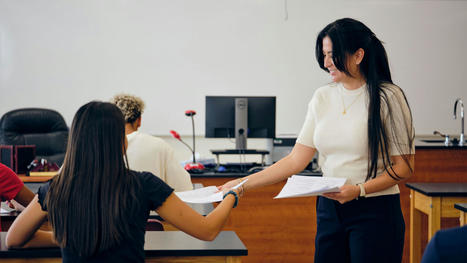




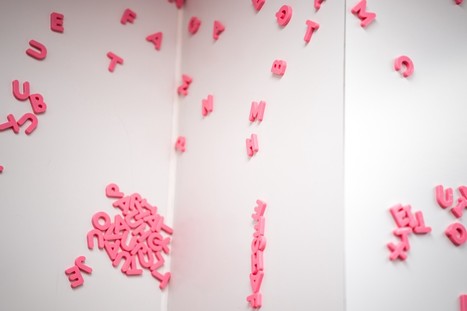
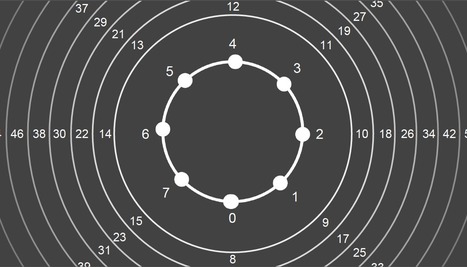



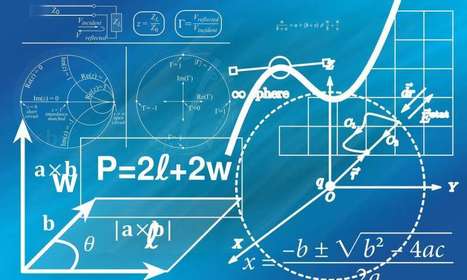

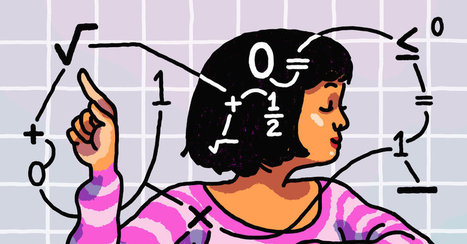
![Mind-Body Math: Manipulatives in the Digital Age [Infographic] | Professional Learning for Busy Educators | Scoop.it](https://img.scoop.it/V0Mn3_eIB3RoN96_wjBUYDl72eJkfbmt4t8yenImKBVvK0kTmF0xjctABnaLJIm9)










